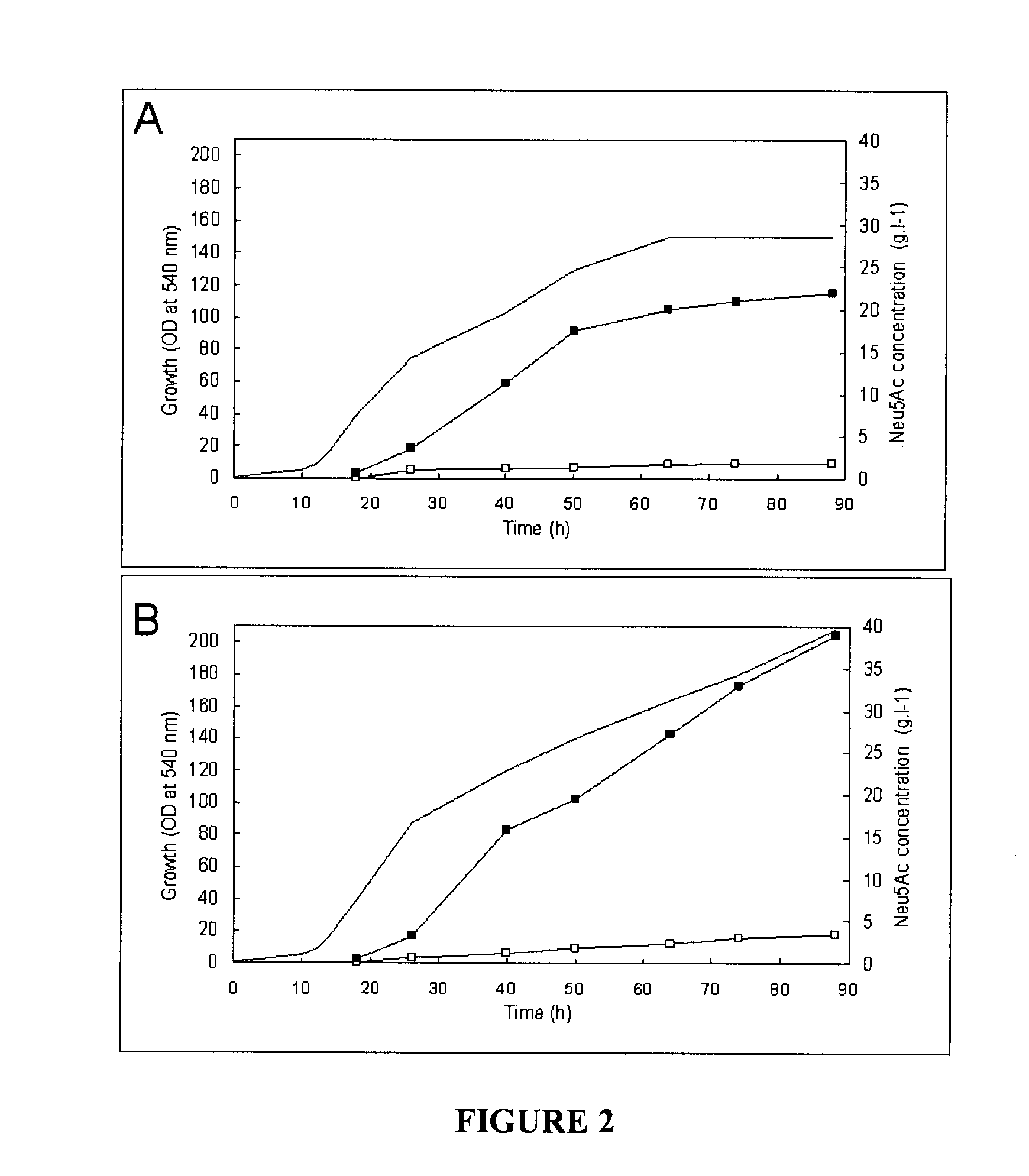High yield production of sialic acid (neu5ac) by fermentation
a technology of sialic acid and fermentation, which is applied in the field of high-quality production of sialic acid (neu5ac) by fermentation, can solve the problems of low overall production yield, low manufacturing cost of neu5ac, and preventing the development of economically practical industrial processes
- Summary
- Abstract
- Description
- Claims
- Application Information
AI Technical Summary
Problems solved by technology
Method used
Image
Examples
example 1
Construction of the nanKETA Mutant
[0049]The nanA, nanK, nanT mutant strain ZLKA was constructed from Escherichia coli K12 strain DC (Dumon et al., 2005). In E. coli K12 the nanA nanK and nanT genes are clustered in the same region of the E. coli chromosome together with the nanE gene which encodes the ManNac kinase activity. These four genes were simultaneously deleted by removing a 3.339 kb segment in the chromosomal DNA using the previously described one-step procedure that employs PCR primers to provide the homology to the targeted sequence (Datsenko & Wanner, 2000). The sequence of the upstream primer was 5′GCAATTATTGATTCGGCGGATGGTTTGCCGATGGTGGTGTAGGCTGGAGCTGCTTC (SEQ ID NO 1) and the sequence of the downstream primer was 5′ CTCGTCACCCTGCCCGGCGCGCGTGAAAATAGTTTTCGCATATGAATATCCTCCTTAG (SEQ ID NO 2)
example 2
Cloning of neuBCA Genes
[0050]A 2.995 DNA fragment containing the sequence of the genes neuBCA was amplified by PCR using the genomic DNA of Campylobacter jejuni strain ATCC 43438 as a template. A KpnI site was added to the left primer (5′GGTACCTAAGGAGGAAAATAAATGAAAGAAATAAAAATACAA) (SEQ ID NO 3) and a XhoI site (5′CTCGAGTTAAGTCTCTAATCGATTGTTTTCCAATG) (SEQ ID NO 4) was added to the right primer The amplified fragment was first cloned into pCR4Blunt-TOPO vector (Invitrogen) and then sub-cloned into the KpnI and XhoI sites of pBBR1-MCS3 vector to form pBBR3-SS.
example 3
Construction of Plasmids Expressing the neuC Genes and an Inactive neuA Gene
[0051]In plasmid pBBR3-SS the neuA gene is located downstream the neuC gene. A 0.4 k DNA fragment located in the neuA gene sequence was excised from pBBR3-SS par digestion with BsaBI and SmaI. After ligation the resulting plasmid contained a truncated inactive neuA gene which was called pBBR3-neuBC.
[0052]To increase their expression level, the neuBC gene were subcloned from the low copy number plasmid pBBR3-neuBC into the KpnI and XbaI sites of high copy number plasmid pBluescript II KS, yielding pBS-neuBC.
PUM
| Property | Measurement | Unit |
|---|---|---|
| concentration | aaaaa | aaaaa |
| cell density | aaaaa | aaaaa |
| temperature | aaaaa | aaaaa |
Abstract
Description
Claims
Application Information
 Login to View More
Login to View More - R&D
- Intellectual Property
- Life Sciences
- Materials
- Tech Scout
- Unparalleled Data Quality
- Higher Quality Content
- 60% Fewer Hallucinations
Browse by: Latest US Patents, China's latest patents, Technical Efficacy Thesaurus, Application Domain, Technology Topic, Popular Technical Reports.
© 2025 PatSnap. All rights reserved.Legal|Privacy policy|Modern Slavery Act Transparency Statement|Sitemap|About US| Contact US: help@patsnap.com


